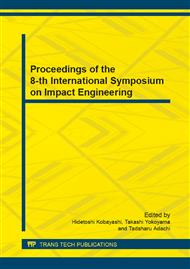p.250
p.256
p.262
p.268
p.274
p.281
p.286
p.292
p.298
Experimental and Numerical Study on the Dynamic Fracture Characteristics of Gray Cast Iron FC200
Abstract:
Recently, some improvements made to machine performance have caused accidents as a result of impact fracture. These fractures were caused by unexpected dynamic loads. To suppress the damage in these accidents, it is necessary to clarify the dynamic fracture mechanism, many reports have been published on dynamic fracture phenomena [1, 2, 3]. Cast iron is used to repair some structural and mechanical parts following fracture accidents. The brittle behavior of cast iron is not desirable for preventing dynamic fracture. It is necessary to clarify the dynamic fracture mechanism of cast iron for the safety design and maintenance of structures. The dynamic behavior of deformation and fracture depends on the size of a structure. In some cases, an experimental approach using specimens at industrial scale is difficult. As a first step, dynamic fracture without a huge mass effect should be discussed. In this study, a normal sized three point bending specimen consisting of cast iron was used in dynamic experiment. An ultra-high speed camera was used to observe crack propagation. Some fractures were caused under eccentric loading, non-straight cracks propagated in this condition. According to the experimental results, the path and velocity of crack propagation were estimated. Fracture criteria were discussed from the results of numerical simulation. To simulate the behavior of crack propagation a moving finite element method based on Delaunay automatic triangulation was used. The prediction of fracture paths based on the fracture mechanics theory was demonstrated in these numerical simulations. The predicted fracture path agreed with the experimental fracture path.
Info:
Periodical:
Pages:
274-280
Citation:
Online since:
June 2014
Authors:
Price:
Сopyright:
© 2014 Trans Tech Publications Ltd. All Rights Reserved
Share:
Citation:


